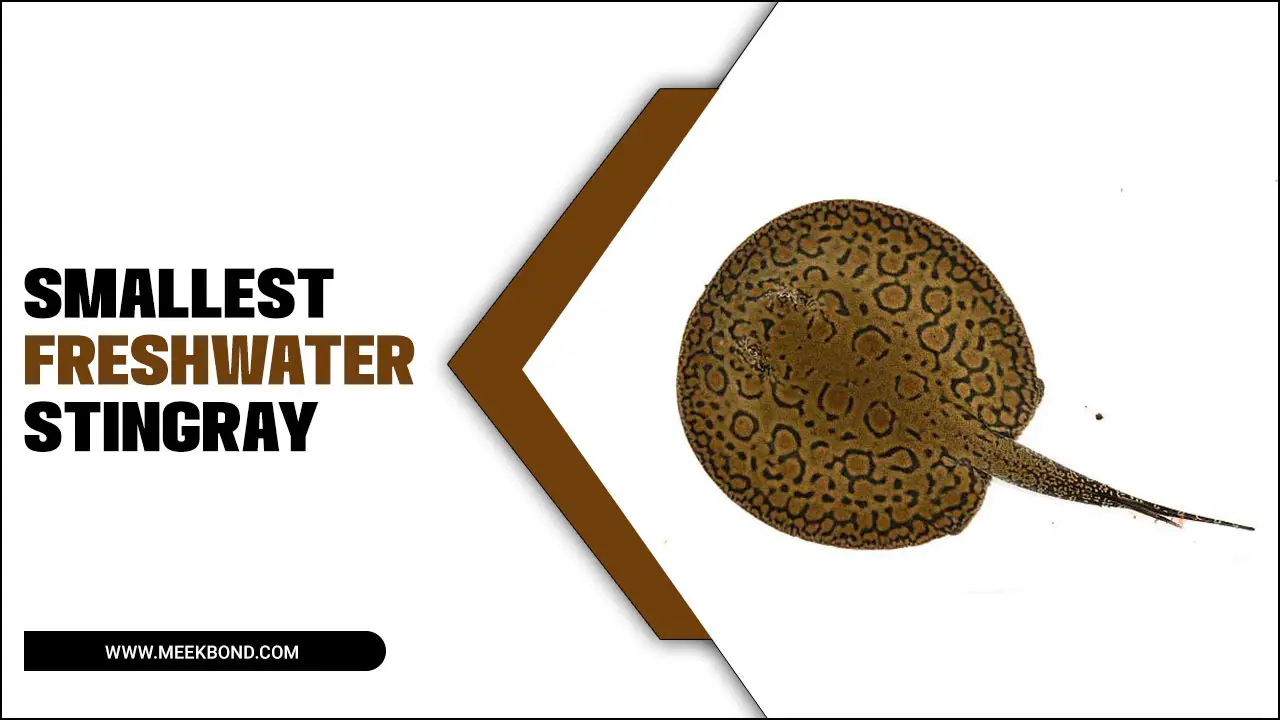Sushi is a delicious and popular Japanese dish that has become increasingly popular around the world. It typically consists of bite-sized pieces of cooked vinegared rice, topped with various ingredients such as raw fish or seafood, vegetables, and sometimes even fruit.
The art of making sushi requires great skill and attention to detail, with each piece carefully crafted to ensure the perfect balance of flavors and textures. Do you want to know the secret behind a perfect sushi experience? It’s all about the fish.
Sourcing high-quality fish that is fresh and safe for consumption is of utmost importance when it comes to preparing sushi. We will delve into the art of curing fish for sushi like a professional. We will cover everything from sourcing fresh fish to different curing methods with salt, sugar, vinegar, soy sauce, miso, and even smoking. Get ready to elevate your sushi game with this authentic Korean recipe on how to cure fish for sushi.

Understanding Sushi-Grade And Sashimi-Grade Fish

MINOLTA DIGITAL CAMERA
Understanding the difference between sushi-grade and sashimi-grade fish is important when it comes to enjoying these dishes safely. This process also helps to enhance the flavor and texture of the fish. On the other hand, Sashimi-grade fish must meet even stricter standards as it is consumed raw and requires a higher level of quality control.
It is typically inspected by a professional with experience in identifying high-quality fish, looking for firmness, color, and texture characteristics. By understanding the nuances of these designations, you can ensure that you’re consuming only the freshest. Highest-quality fish when enjoying your favourite sushi or sashimi dish.
How To Cure Fish For Sushi-Like Professionals

As any sushi chef will tell you, the key to great sushi is using the freshest fish possible. But many people don’t realize that curing the fish is just as important as choosing it. To cure fish for sushi like a professional, start by cleaning and filleting the fish. Then, generously sprinkle coarse sea salt over both sides of the fillets and refrigerate them for several hours (or overnight). This will draw out excess moisture and help firm up the flesh.
After rinsing off the salt, pat the fillets dry and place them in a mixture of rice vinegar, sugar, and sake (or mirin). The acidity of the vinegar will further “cook” the fish while adding flavour and preserving its texture. Let it marinate in the fridge for at least an hour before slicing it thinly for sushi rolls or sashimi use. With these simple steps, you can create sushi-grade fish that’s sure to impress even the most discerning palates. Here are some processes on how to cure fish for sushi.
Sourcing Fresh Fish For Sushi

To source fresh fish for sushi-like professionals, look for a reputable grocery store or fishmonger specialising in sushi-grade or sashimi-grade fish. Choose fresh salmon fillets or other seafood with a firm texture and bright appearance. Before you begin cutting the piece of fish into fillets, make sure you have all necessary utensils on hand, including sharp knives, and paper towels to absorb excess moisture. And plastic wrap to store the fillets before use.
Preparing The Fish For Curing
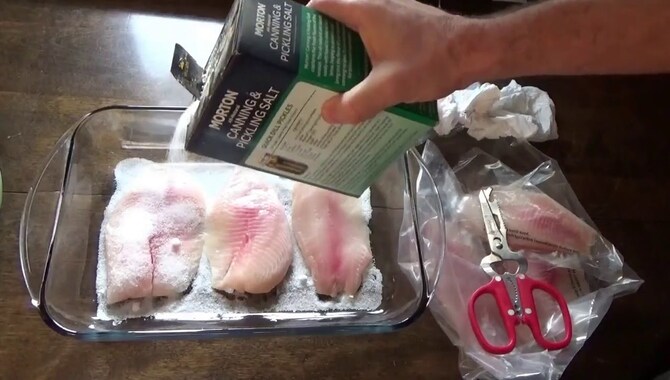
Preparing the fish for curing is essential in achieving the perfect flavor and texture. First, ensure that the fish is fresh and of high quality. Then, remove the head, gut, and scales before washing it thoroughly with cold water. Next, pat the fish dry with paper towels or a clean cloth and slice it into thin fillets or pieces.
It’s important to remove any remaining bones as they can interfere with the curing process. Once you have prepared your fish, you can begin to cure it using salt, sugar, spices, or other ingredients, depending on your desired flavor profile. Proper preparation ensures that your cured fish will be delicious and safe to eat.
Salt Curing
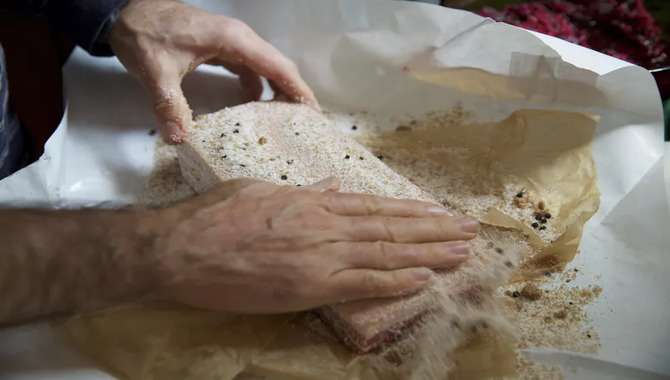
People have used salt curing for centuries as a time-honored technique to preserve meat and fish. The process involves rubbing salt onto the surface of the meat or fish, which draws out moisture and creates an environment that inhibits the growth of bacteria.
This preserves the food and imparts a unique flavor and texture. While modern refrigeration has made salt curing less necessary for preservation purposes. It remains a popular method for creating artisanal products such as prosciutto, bacon, and smoked salmon.
The key to successful salt curing is using the right amount of salt and allowing enough time for the process to work its magic. With patience and attention to detail, anyone can master this ancient technique and enjoy delicious cured meats and fish at home.
Sugar Curing
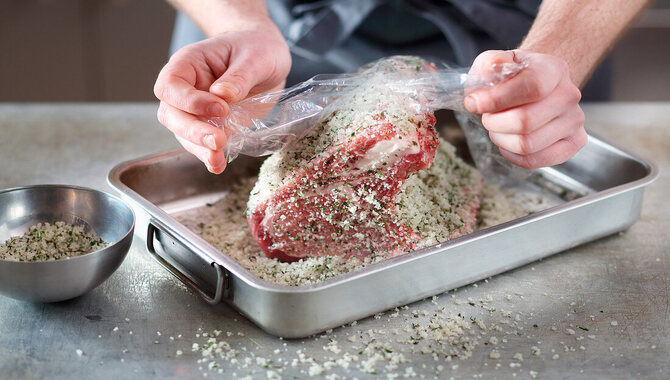
Sugar curing is a preservation method that has been used for centuries to extend the shelf life of meat. The process involves rubbing sugar, along with other seasonings and spices, onto the surface of the meat and allowing it to sit for several days. During this time, the sugar draws out moisture from the meat. Creating an environment that is inhospitable to bacteria and other microorganisms that can cause spoilage.
Once you complete the curing process, you can smoke or cook the meat and it will have a unique sweet and savory flavor that sugar-cured meats have. While modern refrigeration techniques have largely replaced this method. Sugar curing remains a popular choice among food enthusiasts who appreciate its traditional flavor and historical significance.
Vinegar Curing

Koreans have been using vinegar curing for centuries as a traditional way of preparing sushi-grade seafood. Combining rice vinegar with salt and sugar can create a simple yet flavorful pickling solution that removes unwanted odours and flavours from the fish while adding sweetness. After covering a piece of fresh salmon fillet with this mixture for anywhere between 30 minutes to several hours. Depending on its thickness and freshness level, you can cut it into thin slices and serve it as sushi or sashimi.
Soy Sauce Curing
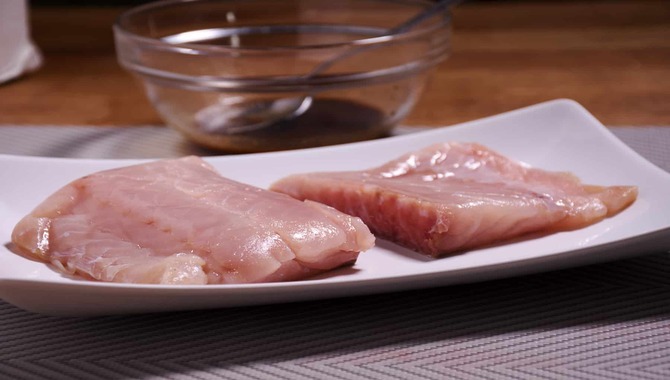
Soy sauce curing is a traditional method of preserving and flavouring food, particularly meats, in Asian cuisine. The process involves marinating the meat in a mixture of soy sauce, sugar, and spices for several hours or even days. The salt in the soy sauce helps to draw out moisture from the meat, which helps to preserve it and prevent spoilage.
Additionally, the soy sauce imparts a deep umami flavour to the meat that is both savoury and satisfying. Soy sauce cured meat can be used in various dishes, such as stir-fries or noodle soups. Or simply enjoyed on its own as a delicious snack. Although it may take some time and effort to prepare, soy sauce curing is a time-tested technique that has been used for centuries and continues to be popular today.
Miso Curing

For an extra burst of flavour and preservation technique for fish in sushi-making is Miso curing. To begin this process of curing fresh fish fillets, combine miso paste with sugar, sake, and mirin. Allow the mixture to coat the fish before being left to cure inside your fridge overnight. Once done curing cut into thin slices and enjoy as sashimi or use it as a filling for sushi rolls. The added umami flavor from miso makes this process well worth it.
Smoking Fish For Sushi
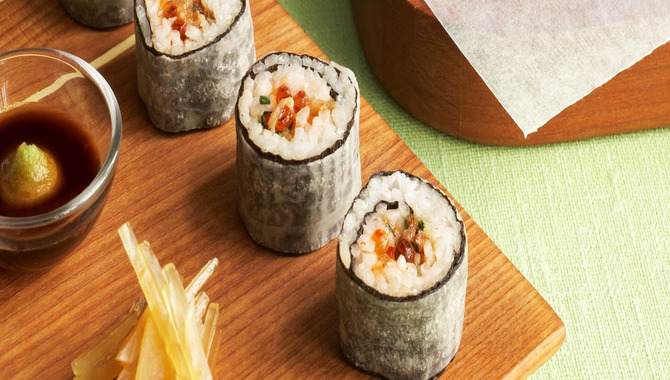
For an elevated sushi experience, try smoking your fish instead of using it raw. Begin by curing the salmon fillets in salt and sugar for several hours or overnight in the fridge to remove excess moisture.
Then move on to smoking the fillets over a wood chip fire to add protection from parasites while giving your dish a unique smoky flavor. Experiment with different types of wood chips like dill or applewood to bring out sweetness or add an umami flavor. Don’t let worms ruin your homemade sushi experience! (Total word count: 81)
Curing Fish For Nigiri Sushi

For the perfect nigiri sushi, choose a piece of fresh salmon fillet and make sure to. Thaw it properly before starting the curing process. To draw out excess moisture and enhance its flavour, gently rub sea salt and sugar onto the fillet while evenly coating it.
Add some dill for extra sweetness and place it in the fridge overnight on a bed of plastic wrap or paper towels for optimal freshness. When cutting the cured salmon, use a sharp knife on a clean cutting board and serve with wasabi, soy sauce, and pickled ginger.
Curing Fish For Sashimi
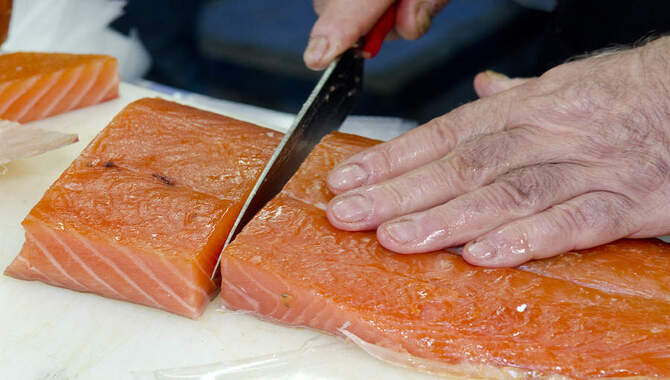
To ensure a flavorful dish of sashimi, always use fresh, high-quality fish that has been properly handled and stored. Draw out excess moisture from the piece of fish by rubbing it with a mix of kosher salt and sugar. Add protection against parasites by freezing for 24 hours before thawing at room temperature.
Marinate the fillet in vinegar and seasonings like dill or rice vinegar for sweetness. Slice thinly with a sharp knife on a clean cutting board, using a paper towel to remove excess moisture. Serve with wasabi and soy sauce for an added kick.
Storing And Serving Cured Fish For Sushi
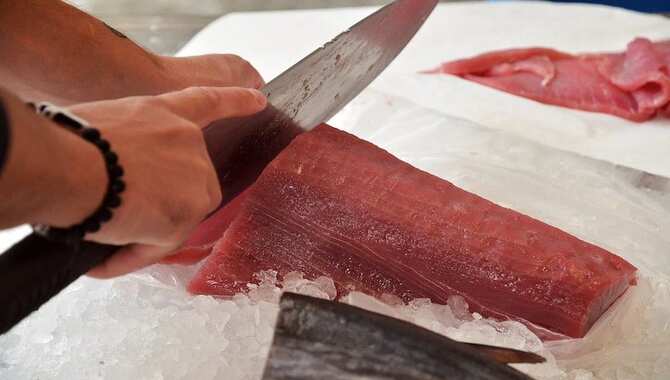
To keep the freshness and quality intact while storing and serving cured fish for sushi at home. Like in Japanese restaurants, place the fillets on a paper towel to absorb excess moisture. Then wrap it with plastic or put it in an airtight container before keeping it in the fridge for up to three days.
Cut them into thin slices before serving cured salmon or tuna fillets, which can be arranged on top of sushi rice. Or used as a filling for sushi rolls. And yes! Follow proper food safety guidelines while handling raw seafood.
FDA Guidelines For Safe Consumption Of Raw Fish

To consume raw fish safely, the FDA recommends freezing the seafood to kill any possible parasites. It is important to source sushi-grade fish from a reputable supplier and handle and store it properly. To prepare sushi at home, follow food safety guidelines and consult a healthcare professional.
As a general rule for homemade sushi, use proper utensils, such as plastic wrap or paper towel, when cutting and filleting the fish to avoid parasitic infection. Always keep the salmon fillets in the fridge or freezer, removing them only when ready to cure or thawing them in cold water.
Adding kosher salt is an excellent way of removing moisture from the surface of the piece of fish that you want to cure, giving additional protection against bacteria and parasites.
Assessing The Risk Of Parasites In Raw Fish
Assessing the risk of parasites in raw fish is an important consideration for anyone who enjoys sushi or other uncooked seafood dishes. While raw fish can be a delicious and healthy choice, it can also carry a risk of parasitic infection.
This is because many types of fish, particularly those that are caught in the wild, may contain various types of parasites that pose a risk to human health. To mitigate this risk, it’s important to ensure that any raw fish you consume has been properly handled and stored.
Fish should be frozen at very low temperatures for a certain amount of time before being served raw to kill off any potential parasites. Additionally, sourcing fish from reputable suppliers and restaurants can help minimize the risk of parasitic infection. Taking these precautions allows you to enjoy raw fish flavours and health benefits while minimizing your risk of parasitic infection.
Managing Temperature And Bacterial Contamination
Managing temperature and bacterial contamination is crucial in maintaining a safe and healthy environment. Proper temperature control can prevent the growth of harmful bacteria and ensure that food and other perishable items are stored at safe temperatures.
This is particularly important in the food industry, where bacterial contamination can cause serious health problems for consumers. To manage bacterial contamination, it is essential to implement proper hygiene practices, such as regular cleaning and sanitization of surfaces and equipment.
Additionally, using antimicrobial materials and coatings can help to reduce the growth and spread of bacteria. Implementing these measures makes it possible to maintain a clean and safe environment that promotes good health and well-being for all.
Conclusion
To make delicious sushi, curing your fish properly is essential. Whether a professional chef or a home cook, mastering the art of curing fish can take your sushi-making skills to the next level. Curing fish for sushi is a delicate process that requires skill and precision.
Whether you’re a professional sushi chef or an amateur cook, knowing how to cure fish for sushi can take your cooking skills to the next level. By following our authentic Korean recipes, you can become an expert in curing fish for sushi.
However, it’s important to remember that curing raw fish carries some risks. Always follow FDA guidelines and assess parasite risk before consuming raw fish. Proper storage and handling of cured fish is important to avoid bacterial contamination. Impress your guests with a delicious sushi platter by mastering the art of curing fish for sushi.
Frequently Asked Questions
Does Fish Need To Be Cured For Sushi?
Fish needs to care for sushi to improve its flavor and texture. Curing involves adding salt and sometimes sugar to remove moisture and kill any bacteria or parasites present in the fish. Different techniques like dry-salting, wet-salting, and marinating can be used.
Should I Use Table Salt To Cure Fish?
Table salt can be used to cure fish, but it is recommended to use a high-quality sea salt or kosher salt for better results. These salts have larger crystal sizes and fewer additives, which gives them a milder flavor and consistency.
Is It Okay To Eat Raw Salmon In Sushi?
Raw salmon in sushi is safe if properly handled and prepared, but there is a risk of parasites or bacteria if the fish is not fresh or frozen correctly. Choose reputable restaurants that follow food safety practices. When making sushi at home, use high-quality fresh fish and follow proper preparation guidelines.
What Are The Benefits Of Eating Raw Fish?
Consuming raw fish from reliable sources can provide a good source of protein, omega-3 fatty acids, and vitamins. It may also reduce the risk of heart disease, boost brain function, and aid digestion. However, being cautious about where you get your raw fish is crucial to prevent foodborne illness.
Is It True That You Can’t Eat Raw Fish If You Have A High Risk Of Food Poisoning?
Consuming raw fish can lead to food poisoning if mishandled. Those with weakened immune systems or underlying health issues have a higher risk. To reduce risk, only consume fresh, high-quality fish from trusted sources. When in doubt, consult a healthcare professional before consuming raw fish.

Aquarium passion is all about connecting with the aquatic life and providing education to the public on the importance of these creatures. We showcase a wide variety of marine life through our exhibits as well as working with schools to provide unique learning opportunities for students of all ages.


